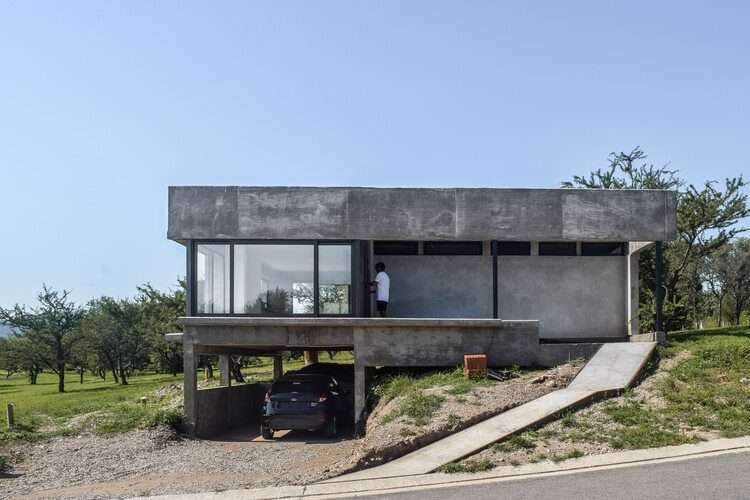Refuse//Repose
Armstrong Gallery at Kent State University
132 South Lincoln Street
Kent, Ohio
Through August 2023
To conclude the 2022–23 Schidlowski Emerging Faculty Fellowship at Kent State University, designer and educator Andrew Economos Miller organized an exhibition and event series that deconstructs the contemporary built environment. Behind the gallery’s storefront-like wall, Refuse//Repose stages a collection of salvaged objects and reimagines the afterlife of architectural waste through collective action.
These derelict objects fit between 21 reused metal stud frames that divide the gallery into several rooms and, in this format, come to function like display panels. 15 in total are filled with architectural debris that, together with student assistants Dominic Holiday and Nguyên Lê, Miller scavenged from junkyards in Cleveland, Ohio Akron, Ohio, and Pittsburgh, Pennsylvania.

Upon entering, viewers might feel like they’ve wandered into a Midwest antique mall, walking among four rooms that function like display booths beyond the glass front. Each room showcases the team’s disembodied objects ranging from a pew kneeler, mannequin fragments, and a massive sconce to entire window frames, balusters, and recycled spolia from former Schidlowski exhibitions.


The culmination of this fellowship is typically a single exhibition, but Miller complemented their show by organizing a conversation series with several leading figures in art and architecture working on the pressing issues of material cycles, labor, and waste.
“Trash and architectural debris are the main material components of the work,” Miller said at the opening conversation with associate professor Jean Jaminet and gallery coordinator Ryan Scavnicky. “The inconsistency of trash forces one to engage in a material-first mode of production against the western modern conception of architecture as a formal-first field.” Their use of trash is partly an ideological choice to anonymize themself, and provokes questions of craft, but the discursive effects of Refuse//Repose are greater than the sum of its parts.
Miller’s “Waste Management” conversation with architect, author, and educator Kiel Moe focused on architecture as a global process of unbuilding rather than as a finite designed object. Moe asserted that the only effective way for architecture to address economic and ecological brokenness is by establishing practices that actively dismantle that brokenness. Refuse//Repose explores the possibility of such a practice with its decentralized labor process and use of reclaimed materials.
“Trash Talk,” a conversation with executive director of Cleveland’s SPACES Gallery Tizziana Baldenebro, focused on the ubiquity of plastics in Ohio and her show Everlasting Plastics, staged in the U.S. Pavilion at this year’s Venice Architecture Biennale. They discussed plastic as a common denominator between Cleveland and Venice, and asked some difficult questions: How has the imbrication of the artificial within the natural changed how we see and live in the world? How might plastic be reproduced within a decolonial frame apart from modernist forms of industry?
“Junk Food” with architect and educator Sarosh Anklesaria envisioned new disciplinary alliances and asked how architects might privilege care, repair, and maintenance to produce new visual cultures. Anklesaria identified Construction Junction—a massive surplus material warehouse in Pittsburgh—as a “preexisting mode of anti-modernism” that could enable circular, non carbon-based economies. Several materials used to make Refuse//Repose were salvaged from Construction Junction, extending the exhibition into its sources of material exchange.
Beneath all the irresistible trash puns, each discussant orbited the possibility for architecture to engage with issues of labor and waste by dismantling unjust economic exchanges, delaminating from oppressive sectors of industry, and reinforcing circular economies already in place. Refuse//Repose registers these ideas not only in the multiauthor construction of each panel, but also in the stories these panels tell.

The exhibition draws many comparisons, from the kitschy appeal of antique stores to the installation art of Louise Nevelson, but its most pertinent allusion may be to Robert Smithson’s infamous Partially Buried Woodshed, installed at Kent State in January 1970. Where Refuse//Repose is made from decay, Partially Buried Woodshed was made to decay, and fulfilled Smithson’s long-held desire to facilitate the decomposition of a building by burying it.
This work was made by piling earth over a woodshed until the central beam cracked. Following the notorious 1970 Kent State shootings, Partially Buried Woodshed surpassed its kinship to Smithson’s then-recent “pour” sculptures and was elevated to the status of symbol when someone anonymously painted “MAY 4 KENT 70” onto its header. The cracked beam came to represent, as if the whole country were cracking, the deep socio-political conditions dividing the country during the Vietnam War.
Both Refuse//Repose and Partially Buried Woodshed resist a singular image, or perception, that can be extracted from their temporal duration. Like Smithson’s half-buried ruin, Miller reuses traces of northeast Ohio’s history to enter into dialogue with layers of time, and with their own interpretations. Refuse//Repose is an anti-romantic mise-en-scene of derelict objects; a ruin in reverse that, if only for a moment, intercedes in the fate of its materials as lost to decay, and reconstructs them to foreground new discursive spaces.
Beyond the use of architectural debris, Miller articulated this ‘material-first’ installation as an allegory for the stratified power structures that dominate the design and construction industries. Refuse//Repose lays bare the decentralized forms of labor that made it, the engaging conversations it staged, and the sometimes belabored yet indispensable questions those conversations posed.
Paul Mosley is an assistant professor of architecture and urban design at Kent State.



